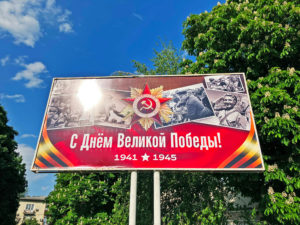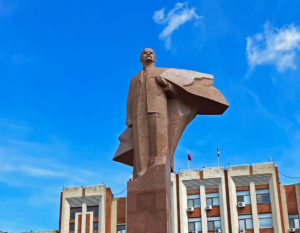Shopping, not fighting. Credit: Daniel Miahilescu/AFP/Getty
Tiraspol, Transnistria
The road is quiet, and the day is hot outside the administrative HQ of the Operational Group of Russian forces in Tiraspol. A few peeling murals of past triumphs can be seen over the wall. A notice promises that “Wartime service in the Russian army is a real man’s activity”.
A weathered-looking soldier with the Russian tricolour on his arm stands guard at a run-down depot across the road. He stares at the sky with a cigarette in his mouth, rifle hanging limp at his side. A modern digital camouflage pattern cover stretches awkwardly across his wide bowl-shaped helmet, which belongs to a different era.
A rusty gate swings open. Another middle-aged man with a paunch pushes a wheelbarrow onto the road. He chirpily asks how I am doing and, discovering I am a foreigner — a military-aged Westerner at that — laughs and nonchalantly waves me away.
These men are a snapshot of the rogue, disconnected Russian forces of Transnistria. Mostly locally recruited, the 14th Soviet Guards Army, fewer than 2,000 men, were reportedly put on full alert on April 26. If such an order has been issued, it is being carried out with a lethargy reflective of this breakaway republic as a whole.
While the armed forces offer regular pay, reliable housing, and social security, young men, who ought to carry the military vitality of this society, resist its call. They do not flock to join the army.

Instead, they, like the young women here, want out. Average salaries on this side of the Dniester River are around 200-300 US Dollars a month. Travelling through the country, it becomes apparent — despite the existence of a few cafés with Instagram-friendly decor — that Transnistria’s raison d’être is to soothe the anxiety of nostalgic pensioners.

 Main Edition
Main Edition US
US FR
FR







Join the discussion
Join like minded readers that support our journalism by becoming a paid subscriber
To join the discussion in the comments, become a paid subscriber.
Join like minded readers that support our journalism, read unlimited articles and enjoy other subscriber-only benefits.
SubscribeIt’s not a “legal grey zone”. It’s not a country. Period. The economy is largely based on smuggling.
Transnistria is part of Moldova that the Russians attempted to steal after 1991. And Moldova is part of Romania that the Russians stole in 1945. The sooner this gets back to one country and the Russians stop intefering, the better.
Just another Ossetia, East Prussia or Abkhazia. There is no legal grey zone to be found here, merely a location populated forcefully with the help of mass deportations by ethnic Russians in the 40s and 50s. Hopefully one day soon Russia will be forced to withdraw from its WW2 spoils and return to its natural borders.